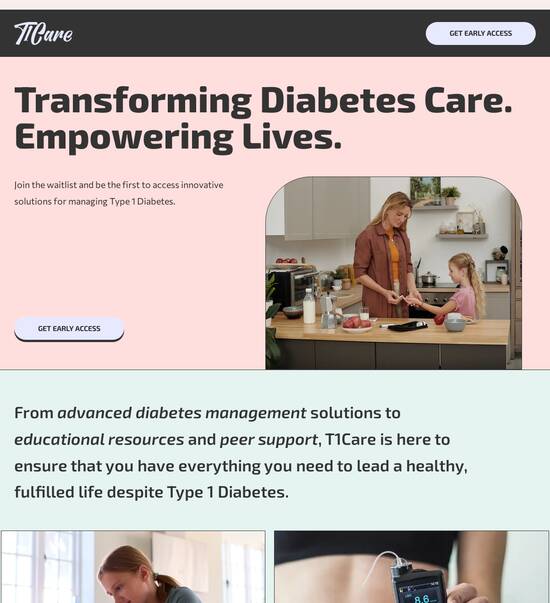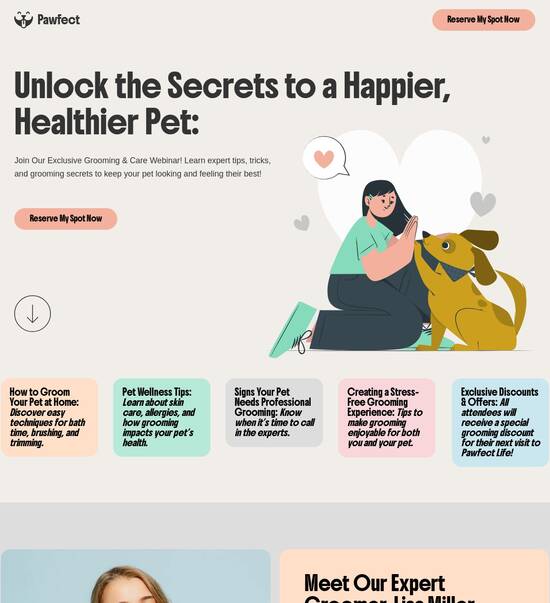
Recipe sharing website template compatible with Ghost
Explore Similar TemplatesAbout template
Streamline your content management with recipe sharing website templates designed for compatibility with Ghost.
Recommended templates

Easy to build without coding
With the intuitive drag-and-drop builder, anyone on your team can create high-converting pages without any knowledge of code or design. Make enhancements to your landing page with custom widgets using Javascript, HTML/CSS, or third-party scripts.

Multiple layouts for any industry and goal
Select from 500+ landing page layouts built to boost conversions across industry-specific scenarios. Customize them by adjusting fonts, adding images, and generating on-brand content with the AI assistant. Quickly scale with Instablocks® and Global Blocks that you can save, reuse, and update globally.

Loads fast and looks polished on any device
Every template is responsive, which means they present professionally on any device and load blazingly fast with our Thor Render Engine. You can also power them up with Google AMP technology to deliver an unparalleled mobile experience and drive higher conversions.

Robust analytics & experimentation
Get real-time updates and reporting across all your devices, showing the number of visitors, conversions, cost-per-visitor, and cost-per-lead. Launch AI-powered experiments, run A/B tests, and use heatmaps to analyze user behavior, then optimize your landing page to maximize conversions.







Easy to build without coding
With the intuitive drag-and-drop builder, anyone on your team can create high-converting pages without any knowledge of code or design. Make enhancements to your landing page with custom widgets using Javascript, HTML/CSS, or third-party scripts.
Multiple layouts for any industry and goal
Select from 500+ landing page layouts built to boost conversions across industry-specific scenarios. Customize them by adjusting fonts, adding images, and generating on-brand content with the AI assistant. Quickly scale with Instablocks® and Global Blocks that you can save, reuse, and update globally.
Loads fast and looks polished on any device
Every template is responsive, which means they present professionally on any device and load blazingly fast with our Thor Render Engine.
Robust analytics & experimentation
Get real-time updates and reporting across all your devices, showing the number of visitors, conversions, cost-per-visitor, and cost-per-lead. Launch AI-powered experiments, run A/B tests, and use heatmaps to analyze user behavior, then optimize your landing page to maximize conversions.
All the features you need to build lead-generating landing pages
Explore more featuresLearn how to build top-performing landing pages for any goal
FAQs
Leading the way in building high-performing landing pages





Unlocking High-Performance Campaigns with Instapage Landing Page and CRO Platform
Instapage empowers marketers to supercharge their online campaigns, making it the preferred landing page and conversion rate optimization (CRO) platform. This step-by-step guide will walk you through utilizing Instapage effectively to maximize the ROI of your digital marketing efforts, specifically tailored for professionals in marketing, tech, education, and financial sectors within the USA.
Understanding the Value of Instapage
Instapage's strength lies in its all-in-one solution for creating and optimizing landing pages that drive conversions. Here’s why it stands out:
- Comprehensive Templates - Access over 100 high-converting templates to help you get started quickly, reducing time and effort in your campaign launches.
- CRO Tools - Built-in features like A/B testing and heatmaps help you identify what works best for your target audience to enhance overall performance.
- Personalization Capabilities - Use dynamic text replacement and AdMaps to align content with specific audience segments for better engagement.
Step 1: Setting Up Your Landing Pages
Creating effective landing pages in Instapage is straightforward. Follow these steps to build your first page:
- Choose a Template - Start by selecting a template that fits your campaign objectives. Customize it using the drag-and-drop builder to match your brand.
- Incorporate Lead Generation Elements - Utilize form fields, buttons, and CTAs embedded within the page to encourage visitors to convert.
- Preview and Publish - Check your landing page on multiple devices to ensure it looks good everywhere, then publish it straight from the platform.
Step 2: Optimizing Your Landing Pages
To maximize conversions, continuous optimization is essential. Here’s how to optimize using Instapage:
- A/B Testing - Create variations of your landing page to evaluate what resonates best with your audience through A/B testing.
- Analyze Heatmaps - Use heatmap functionalities to visualize where users interact most, refining pages based on these insights.
- Review Analytics - Dive into your Instapage analytics dashboard to track conversions and learn about visitor behavior, helping you iterate effectively.
Step 3: Collaborating for Better Results
Maximizing output often involves collaboration. Here’s how Instapage facilitates teamwork:
- Real-time Edits - Allow team members to make edits simultaneously, speeding up the review and approval process.
- Instant Feedback - Share landing pages securely with stakeholders for quick feedback, improving response times.
- Version Control - Maintain a history of changes, enabling teams to revert to previous versions if needed.
With these steps, you’re well on your way to mastering Instapage for your digital marketing campaigns.
Ready to take your landing pages to the next level? Start your journey with Instapage today and unlock the full potential of your marketing efforts.
People also ask about Recipe sharing website template compatible with Ghost
Recipe sharing website template compatible with Ghost
Overview of recipe sharing websites
Recipe sharing platforms have become increasingly essential for food enthusiasts, serving as hubs for culinary creativity. They not only encourage individuals to share their cooking experiences but also help foster vibrant communities where members can connect over their shared love of cuisine. By facilitating the exchange of recipes, these platforms play a critical role in bridging cultural gaps, allowing users to explore diverse food traditions from around the globe.
Moreover, the trends in online recipe sharing are evolving rapidly. The rise of food blogging signifies a shift in how people discover new recipes, with personal anecdotes and storytelling enriching the culinary experience. Additionally, the integration of social media has transformed how recipes are shared. This evolution allows for broader outreach and engagement, as users can share their favorite recipes with their networks, driving more traffic and interaction within these platforms.
Understanding Ghost as a publishing platform
Ghost is a modern, open-source publishing platform that has gained recognition for its simplicity and effectiveness, particularly among bloggers and content creators. Originating as a Kickstarter project in 2013, Ghost has evolved significantly, improving its offerings to cater specifically to users seeking a streamlined blogging experience. Its core features, such as a user-friendly interface and minimalist design, make it particularly appealing for recipe sharing websites where visual presentation is key.
One of Ghost’s standout features is its flexibility and customization potential. Being open-source, developers have the freedom to modify everything from layouts to functionality, ensuring that each recipe sharing site can maintain a unique identity. Additionally, Ghost's headless CMS capabilities allow for seamless integration with various front-end technologies. This means that developers can create custom applications around Ghost while utilizing its powerful content management functions.
Recipe sharing website template features
A well-designed recipe sharing website template compatible with Ghost boasts numerous customizable front-end designs. These themes are essential as they provide the aesthetic appeal that can attract and retain users. Many templates offer diversity specifically tailored to niche culinary interests, such as vegan cooking, international cuisines, or dessert specialties. A responsive design ensures that users have a seamless experience, whether they are accessing the site from a smartphone, tablet, or desktop.
Additionally, a user-friendly recipe submission form is vital. Simple input fields for ingredients and detailed instructions can streamline the process for users who want to share their culinary creations. Incorporating options for photo uploads and video integrations enhances user submissions, making each recipe visually rich and engaging.
Ingredient-based search allows users to find recipes based on available pantry staples.
Dietary restrictions filters help users locate suitable recipes easily.
Categorization by cuisines and meal types aids in efficient browsing.
Enhanced community engagement
Community engagement is a hallmark of successful recipe sharing websites. Allowing users to create accounts and profiles significantly enhances interaction. Acknowledging contributions through profile badges and reputation systems can motivate users to participate more actively, leading to a thriving community where shared knowledge outweighs individual contributions.
Social sharing features further amplify community engagement. By integrating with major social media platforms, a recipe can quickly gain visibility, shared not just among friends but expanded to wider audiences. Creating unique, shareable links for specific recipes also encourages users to promote their favorites. This capability, coupled with a comment and review system, invites feedback and fosters interaction, allowing users to discuss and rate their favorite recipes openly.
SEO and performance optimization
To attract and retain users on a recipe sharing website, SEO and performance optimization are critical. Built-in SEO tools allow website owners to customize meta descriptions and keywords effectively, optimizing visibility on search engine results. An SEO-friendly URL structure further promotes better indexing by search engines.
Fast loading times are crucial for user retention; thus, techniques such as lazy loading images can significantly improve performance. Moreover, mobile optimization cannot be overlooked; ensuring responsive design plays key roles in user experience. Testing across multiple devices and browsers helps guarantee that every user has a seamless experience.
Monetization options for recipe sharing websites
Creating a recipe sharing website not only offers community engagement but also presents various monetization options. Subscription and membership models can provide premium content behind paywalls, benefiting both users seeking higher-quality recipes and creators generating income from their efforts. Offering exclusive content or benefits for members can help build loyalty and sustained engagement.
Advertising integrations can also serve as a revenue stream. Understanding the types of ads that align well with food websites is important, as this ensures that user experience is maintained while monetizing the platform. Additionally, affiliate marketing presents great opportunities by integrating product recommendations that seamlessly align with recipes, allowing website owners to build partnerships with kitchenware brands.
Analytical tools and insights
For recipe sharing websites, utilizing analytical tools is essential for monitoring user engagement. An analytics dashboard specific to recipe sharing can help website owners understand user behavior and preferences effectively. Through tracking metrics such as views, shares, and comments, owners can gather invaluable insights that shape their content strategy.
Understanding recipe performance metrics enables continuous improvement. Being aware of which recipes garner the most traction allows creators to focus on content that resonates most with their audience, ensuring a robust growth trajectory.
Future of recipe sharing on Ghost
As technology continually evolves, the future of recipe sharing on platforms like Ghost appears promising. Innovations such as AI-generated recipe suggestions may streamline the cooking process further, making personalized recommendations based on dietary preferences and prior behavior possible. Moreover, the potential implementation of augmented reality (AR) or virtual reality (VR) can enhance cooking demonstrations, making the learning process more interactive and enjoyable.
Looking at community growth and sustainability, it will be crucial to develop strategies that cultivate a loyal user base. Keeping abreast of trends in the culinary web ecosystem will allow website owners to adapt swiftly and maintain relevance in an ever-changing digital landscape.
Practical steps to launching your recipe sharing website
Launching a recipe sharing website begins with properly setting up Ghost. Several hosting options are available, and installation is straightforward, making it accessible for novice and experienced developers alike. After establishing the foundation, selecting the right template is paramount; the template should align with the desired user experience and brand identity.
Following the setup, developing a content strategy is vital. Planning an initial recipe database with diverse offerings will draw users in, while effective content calendar management ensures consistent updates. Finally, marketing your website involves utilizing SEO strategies and engaging with social media outreach, while partnerships with food influencers can extend reach and boost visibility.
Lessons learned from successful recipe sharing websites
Analyzing case studies of successful Ghost-based recipe sites can yield valuable insights. These case studies often reveal common features and strategies that differentiate them from lesser-known platforms, such as a commitment to high engagement or strong community ties built through user-generated content.
New site owners can take away key lessons from these examples, especially regarding mistakes to avoid in the early stages. Understanding the importance of building a strong brand identity and engaging with users from day one can significantly impact long-term success.
Ready to skyrocket conversions?
Supercharge your ad campaigns with high-performing landing pages
Get started














